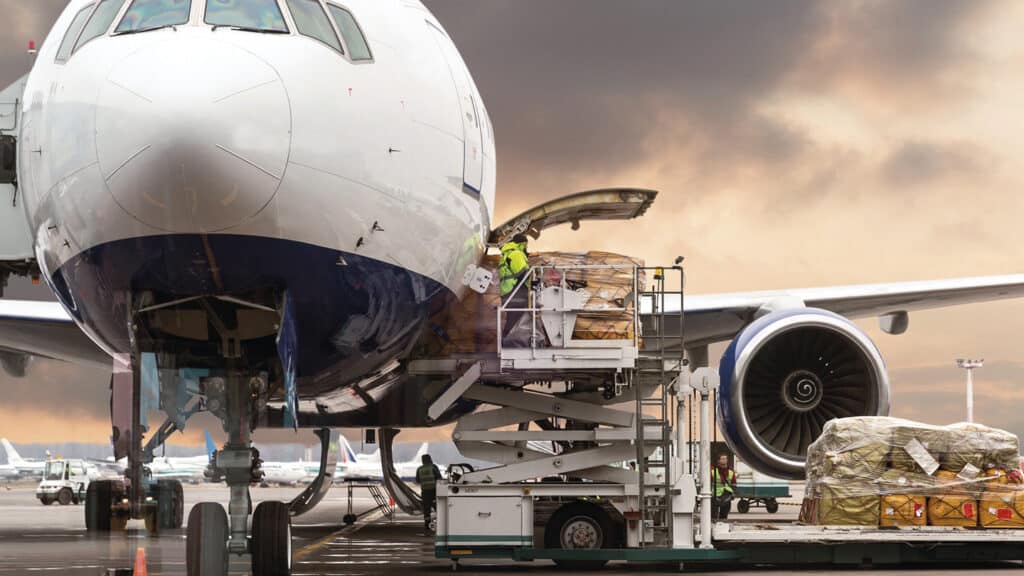International ecommerce logistics: 9 essential questions to consider
As your ecommerce business expands abroad, new challenges emerge. From choosing the channels to sell through, to navigating regulations and beyond — it’s not always straightforward.
International logistics is a key component to get right. Managing your operations efficiently and profitably as you go global hinges on getting your international logistics processes water-tight.
Thankfully you don’t need to walk this path alone — technology, partnerships and learning from the experiences of others are all powerful strings to add to your global bow.
For this article, we caught up with Jonathan Matchett, Senior VP of Landmark Global, to find out the core considerations that retailers should make when expanding their logistics internationally. Let’s dive in!
What is international logistics?
International logistics refers to the management and coordination of the movement of goods across international borders, encompassing everything from transportation, warehousing, and inventory management to customs clearance and compliance with local and international trade laws. This process is essential for companies looking to expand their operations globally, ensuring that products are delivered efficiently, cost-effectively, and in compliance with varying regulations across countries.

What’s involved in international logistics?
Let’s consider each in more detail:
Managing inventory
Effective inventory management is critical in international logistics, as it involves maintaining optimal stock levels to meet fluctuating demands across different countries. This practice helps in minimizing costs through efficient resource allocation while ensuring there is always enough inventory to satisfy market needs without overstocking.
Advanced forecasting techniques and robust inventory tracking systems are often employed to predict demand accurately and manage stock in real-time, reducing wastage and storage costs.
Transportation
Transportation is a cornerstone of international logistics, requiring careful planning of routes and selection of the most suitable transportation modes. This element ensures that goods move efficiently from origin to destination, incorporating factors like cost, transit time and environmental impact.
Managing last-mile delivery is particularly crucial as it ensures that goods reach their final delivery points on time and in pristine condition, directly affecting customer satisfaction and business reliability.
Packaging
When you’re selling internationally, your packaging needs to do more than protect goods during transit — it must also comply with diverse international standards and regulations. Effective packaging is designed to withstand long journeys and varying handling conditions while adhering to legal and environmental regulations.
Companies often innovate in packaging materials and designs to improve sustainability and reduce costs, all while ensuring the safety and integrity of shipped goods.
Customs and compliance
Navigating customs efficiently is fundamental in international logistics. It involves preparing and managing a plethora of documentation required to comply with international trade laws, which vary significantly from one country to another.
Efficient customs handling ensures that goods move quickly through borders, avoiding costly delays and legal penalties. Logistics professionals must stay updated on international trade agreements and regulatory changes to streamline customs processes and expedite shipments.
Order fulfillment
Order fulfillment in international logistics entails a complex array of activities designed to ensure that the correct products are delivered to the right customers promptly and accurately. This process often involves coordinating multiple logistics partners and handling systems across various countries and continents.
Effective order fulfillment strategies include integrating technology solutions for order tracking, employing strategic distribution centers and optimizing inventory levels to ensure timely deliveries regardless of location.
A 3PL might be a sensible option here — and according to Steve Suh, “I think there are advantages in looking at a cross border international 3PL because you’re able to optimize on your international shipping costs. If you’re trying to ship internationally from the US, it’s just really expensive right now… and [with a 3PL] you’re looking at least 50 percent savings.”
What are the challenges in international logistics?
The inherent complexity of moving goods internationally means that there are a range of hurdles to be overcome. From costs, to customer satisfaction, to the limitations of technology — there are important considerations to make along the way to ensure the seamless flow of goods to customers in foreign lands.
Here are the five most-pressing challenges:
- Rising costs: Factors such as fluctuating fuel prices, varying labor costs across regions, tariffs imposed by different countries and premiums for insurance policies all contribute to the financial burden of international logistics.
- Delivery times: When selling internationally, the physical distance goods need to travel, potential delays during customs clearance and reliability issues with carriers can lead to inconsistent transit times. This unpredictability can strain customer relationships and complicate inventory management.
- Tech stack limitations: Disparities in digital infrastructure in different countries can hinder the deployment of unified tech solutions, impacting efficiency and visibility across the supply chain. Systems like Linnworks, which streamline commerce operations across platforms, are vital for managing the complex data and operations of international ecommerce logistics.
- Infrastructure limitations: Infrastructure limitations in certain locations can pose significant challenges when shipping internationally, affecting everything from storage capabilities to speed of distribution. Businesses must either invest in infrastructure development or partner with local entities to overcome these hurdles.
- International customs and taxes: The diversity of customs regulations and tax laws across countries can lead to significant delays and increased costs if not managed properly. Logistics operators must have expert knowledge and systems in place to handle these complexities efficiently, ensuring compliance and avoiding penalties.
International ecommerce logistics: 9 essential questions to consider

According to Jonathan Matchett from Landmark Global, there are nine questions that ecommerce retailers should ask themselves when expanding their logistics internationally.
1. Where are your international customers?
Enquiries from existing prospects or customers might already have given you an idea of international market opportunities. Delve deeper into your website’s analytics and you’ll see browser traffic volumes (customers!) by country. Maybe you already know that you appeal to customers in Ireland (nice and close), or the USA (we share the same language – shopping), or across the GCC (ecommerce is booming), or everywhere.
That insight might drive an early conclusion which is to keep your options global. Linnworks powers your entire ecommerce operation, from order management to inventory management and shipping. A seamless integration from Linnworks to Landmark Global gives you instant access to global ecommerce shipping and delivery. It’s a partnership that works for you and your customers.
2. What shipping services do your customers want?
Treat delivery as an extension of your brand promise. You’ll likely want to offer your customers a choice of shipping services. An important consideration is that your new delivery processes are understood by the customer. Full tracking visibility is a big plus, to reassure and update customers on delivery progress.
Is Express the best option for your customers’ orders? It’s fast and expensive. “Standard tracked” often offers the best mix of speed, economy and quality. These standard tracked services typically use a mixture of courier and postal final mile delivery, with most European line hauls done by road from the UK and elsewhere serviced by air.
Work with a delivery partner that offers you the best choice for each of your key international markets. Consider a partner that offers a choice of delivery to the customer’s home or to an alternative pick-up point (“PUDO”, such as a parcel shop or locker). Look for end to end solutions that consider tax and duty treatment, clearance and final mile expertise.
3. How hard is it to ship to Europe?
Two big changes impacted ecommerce from the UK in recent years: Brexit and Import One Stop Shop (IOSS).
It was mostly the unknowns around shipping after Brexit in January 2020 that turned retailers off from shipping to Europe, many of which have been clarified since. IOSS in June 2021 had a greater impact. Retailers register for IOSS, to pay sales tax at the point of sale rather than at the border clearance. IOSS has made tax fairer for EU tax authorities, and for orders up to €150 the delivery experience for the consumer feels like DDP, i.e. with all taxes having been managed pre-delivery.
What if you want the benefits of IOSS without the cost and complexity of registering for IOSS? That’s where Xendo comes in. Xendo has developed a unique Shopify App that enables Xendo to seamlessly validate and collect IOSS charges on behalf of ecommerce sellers on a post checkout transactional basis. Xendo manages the admin, your EU VAT filings, also any VAT reclaim on returns – more of which later.
4. Customs clearance is key – what part does data play in that?
If there’s one thread running through international ecommerce logistics it’s the need for data quality. That’s true in automated bar code reading along every leg of the supply chain.
It’s true in ensuring visibility and tracking of each of your customers’ orders. And it’s doubly true in ensuring seamless border crossings. Work with a delivery partner who can help you structure, manage and clean your data for international ecommerce logistics. Or work with a data specialist who can ensure your data and orders are compliant (no restricted goods, no sending to denied parties) and that each product you are shipping is assigned the correct Harmonized System (HS) code to harmonize it for seamless customs clearance and the correct application of tax and duties.
5. What’s packaging got to do with it?
One consideration in international delivery is the packaging of your customers’ orders. We’re all familiar with small orders that arrived in a big box. Delivery pricing for orders sent by road is typically deadweight, whereas pricing for orders shipped by air is typically volumetric. That’s because airlines charge for space used rather purely by weight.
Many final mile delivery carriers do the same, charging based on the size of the package. It’s worth considering using smaller packaging sizes, and bags rather than boxes where possible, to keep delivery costs to a minimum.
6. “Your order’s on its way” – what’s the best way to keep customers informed?
So, you’ve dispatched your customer’s order. You’ve let them select a delivery option aligned with their expectations for speed, cost and convenience. Even better, you’ve told them within the checkout process who your shipping partner is and the expected transit time – a promise, but not over-promised.
Give your customer the ability to track their order to delivery. The right delivery partner will give both you and your customer visibility of each order’s progress through logistics milestones at origin, in transit and at destination. The more your customer can receive on the go updates, the more reassured they’ll be and the less likely they are to contact your customer service team with queries.
7. How important are returns?
Inevitably, there will be orders not possible to deliver – perhaps the delivery address was wrong and couldn’t be corrected, or the customer refused delivery. You will likely want these “undeliverables” returned to your fulfillment center.
Secondly, some customers will want to return part or all of their order. Again, you’ll likely want these “unwanted” orders returned to your facility in your home country. Alternatively, maybe you’d prefer them to be returned to a local facility and inventory at destination, or donated to charity or sold through an alternative local sales channel.
You might also want to consider including quality assurance services as part of the checking and decision making for what reverse logistics flow for each specific order to take. For each of these considerations, it’s advisable to choose a partner with expertise in the full end-to-end, in reverse logistics as well the outbound delivery journey.
8. How fast can you get set-up?
Maybe you’re already selling internationally – in which case hopefully this guide gives you some pointers as to what more to consider. Or, perhaps international is a completely new growth opportunity. You might be asking how long does it take to get up and running?
The good news is that the integration between Linnworks and international ecommerce logistics experts including Landmark Global is already in place. Your gateway to global selling is ready. Set up and onboarding to ship globally with Landmark Global typically takes 1 to 2 weeks. The steps are as follows:
- Share profile info and services wanted.
- Confirm pricing and terms.
- Share onboarding information.
- Test the integration: create test labels.
- If wanted, send and track test parcels.
- Align and meet each other’s operations and client service teams.
- Set up collections.
- Go live!
9. What’s next for international ecommerce logistics?
So you’re up and running – maybe you started with selling to the USA, then added Canada and Mexico. Maybe you’ve seen growth in UAE, now want to sell to Bahrain and Kuwait. Is Turkey the next big growth opportunity? Where and what’s next for you and for international ecommerce logistics?
Localization is one of the biggest trends and changes. This means translating your website and cart into local language. Beyond that, the site might read right to left. Payment options will be local to the buyer’s market. Pre-sales marketing and post-sales experience, including delivery and customer service are also much better appreciated if localized. US sellers in particular are waking up to the need for localization, in sync with an acceleration and adoption of cross-border selling ex-US.
Being able to offer fully landed cost has gained and continues to gain momentum. This is using tech, in a seamless integrated way at checkout, to calculate tax, duty and shipping within the checkout, to collect those payments and to pay the relevant fiscal authorities at destination. That’s made the collaboration between ecommerce sellers, delivery businesses and the technology/fiscal providers much more entwined and co-dependent.
5 Tactics to make international ecommerce logistics (almost) a breeze

Now that we understand the challenges and the considerations for your international logistics journey, let’s consider the practical solutions that you can put in place to make your international ecommerce logistics a breeze… or almost! Here are five tips to help:
1. Get the right tech in place
In the intricate world of international ecommerce logistics, employing the right technology is not just beneficial — it’s essential. Advanced tech solutions, such as Linnworks, streamline operations by integrating various aspects of commerce, from inventory management to order processing and multi-channel sales. By implementing such systems, businesses can dramatically enhance their operational efficiency, improve real-time data accuracy and provide better customer service through faster processing times and clearer communication channels.
2. Comply with international regulations
Navigating the complex web of international regulations is a daunting task that, if done correctly, can prevent a multitude of costly fines and operational delays. It is crucial for companies to invest in comprehensive compliance programs that include training for staff, regular audits and a strong compliance team that stays updated on international laws and regulations.
This proactive approach not only minimizes the risk of non-compliance but also ensures smoother, more predictable cross-border transactions. Utilizing a service like Landmark Global, who has extensive in-house competence in this arena, is a wise decision.
3. Choose the right fulfillment partner
Selecting an appropriate fulfillment partner is critical when expanding logistics operations internationally. Companies like ShipBob and Landmark Global specialize in handling the nuances of international ecommerce logistics, offering expertise in local customs, optimal shipping practices and inventory management in different regions.
These partners can significantly reduce the burden of managing international shipping and logistics complexities, enabling businesses to focus on expansion and customer service.
4. Diversify your shipping carriers
Relying on a single carrier for international ecommerce logistics can be risky due to potential service disruptions, regional limitations, or pricing fluctuations. By diversifying shipping carriers, businesses can enhance their delivery network’s resilience, negotiate better rates and optimize delivery times based on geographic and service strengths of different carriers. Landmark Global offers a rich mix of carriers to ensure competitive rates, flexible shipping options — and customer satisfaction.
This approach not only improves flexibility and reliability but also ensures that operations can continue smoothly in case of regional disruptions or carrier-specific issues.
5. Get your packaging right
Effective packaging plays a pivotal role in international ecommerce logistics, serving dual purposes of protecting goods during long and often rough transits and ensuring compliance with diverse international standards and regulations. Investing in high-quality, durable and regulatory-compliant packaging materials can significantly reduce the risk of damage, which in turn, decreases the costs associated with returns and replacements.
Sustainable packaging options also can help appeal to environmentally conscious consumers and help meet regulatory requirements regarding environmental impact.
Why you need Connected CommerceOps in 2024
As your ecommerce business expands around the world, having a Connected CommerceOps platform in place is no longer optional. Businesses that adapt to integrated technological solutions will find themselves at a competitive advantage, capable of navigating the complexities of international ecommerce logistics with greater ease and efficiency.
Linnworks offers essential capabilities to retailers who are expanding internationally, including:
- Connectivity: Our solution offers unparalleled connectivity, allowing retailers to tap into a broad spectrum of marketplaces, including big names like eBay and Amazon, as well as niche platforms. This wide-reaching connectivity is pivotal for retailers who are looking to localize and target a diverse consumer base effectively.
- Automation: Linnworks stands out for its robust automation capabilities, which streamline and expedite many of the traditionally labor-intensive ecommerce processes such as listing products, managing stock, processing orders, and handling shipments. These efficiencies are compounded as your business scales abroad.
- Centralization: Linnworks acts as a centralized hub, giving you a comprehensive overview and control of listings, inventory, orders, and shipping processes all from one dashboard. This integration is crucial for maintaining consistency across various channels, keeping track of stock levels, and providing seamless customer experiences.